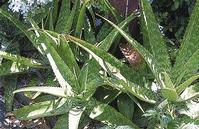Shelly-Ann Thompson, Freelance Writer

The Constitution Hill Women's Group has transformed the juice of the aloe vera plant into a scintillating wine. - photo by Rita Elliott
Surprisingly, aloe vera that is known for its bitter taste makes an invigorating, scintillating wine. Its taste has been likened to white wines such as Chardonnay.
This award-winning product was distilled by the Constitution Hill Women's Group of St. Andrew. The group consists of mostly housewives whose main source of income is farming. The group is one of the most established Rural Agricultural Development Authority (RADA) home economics groups.
Still in its early stages of production, as standardisation and proper labelling are to be done, the women group's aloe vera wine won a gold medal last year at the Jamaica Cultural Development Commission's Culinary Arts Festival. The wine was also a hit on patrons at last month's Denbigh Agricultural Show.
Good response
"The response has been very good because the medicinal value and the herbal benefits of aloes ( strengthens the back and boosts sexual competence), is valued and accepted," said Brenda Green of RADA.
Recognised as a bitter plant and perceived as being an ingredient for bowel movement, prior to having a glass of the wine, memories of getting a 'wash out' during the holidays before resumption of school might be conveyed. However, Mrs. Green noted that it is unlikely that the wine will have this effect. "It is not like you will be drinking a large amount."
Regarding the taste, she said the group makes two different types of the aloe vera wines. "There is one for the Rasta man and another for those who don't like the bitter taste of aloes. The Rasta man thinks that the wine doesn't do justice to aloe vera when it is not bitter. While the 'bald head' thinks
differently."
To remove the bitter taste, aloes are washed. This process does not eliminate the nutritional values of aloe vera. "Aloes are desert plants, so they can withstand a lot of heat. So even if you boil the aloes it still has its nutrients," said Mrs. Green.
They began production of aloe vera wine in 2004. The women debated about the wonderful properties and by-products of the aloe vera. With testing, the wine was developed.
"This was also in an effort to produce an item where raw material was inexpensive," said Mrs. Green.
Since then, the women have been warming the country with the captivating taste of the wine.
Currently, the group is seeking funding to make the production of the wine a business venture. It is not widely distributed as they have not completed the proper registration of the wine by the Bureau of Standards.
"The wine has not been introduced widely because it is in the testing phases." Financial constraints is why the wine is not sold on a wide scale.
"It would be lovely to get a sponsor for the production and marketing of the wine, she said.
For sceptics, Mrs. Green said: "Almost anything can produce a wine, especially fruits and vegetables."
Facts about Aloe Vera
It is a stemless or very short-stemmed plant growing to 80-100 cm tall, spreading by offsets and root sprouts. The leaves are lanceolate, thick and fleshy, green to grey-green, with a serrated margin. The flowers are produced on a spike up to 90 cm tall, each flower pendulous, with a yellow tubular corolla two to three cm long.
It is said to be a source of energy, containing more than 200 nutrients, including 18 amino acids and a variety of vitamins and minerals.
The aloe vera plant is native to Northern Africa.
Popularly known as 'single bible'.

